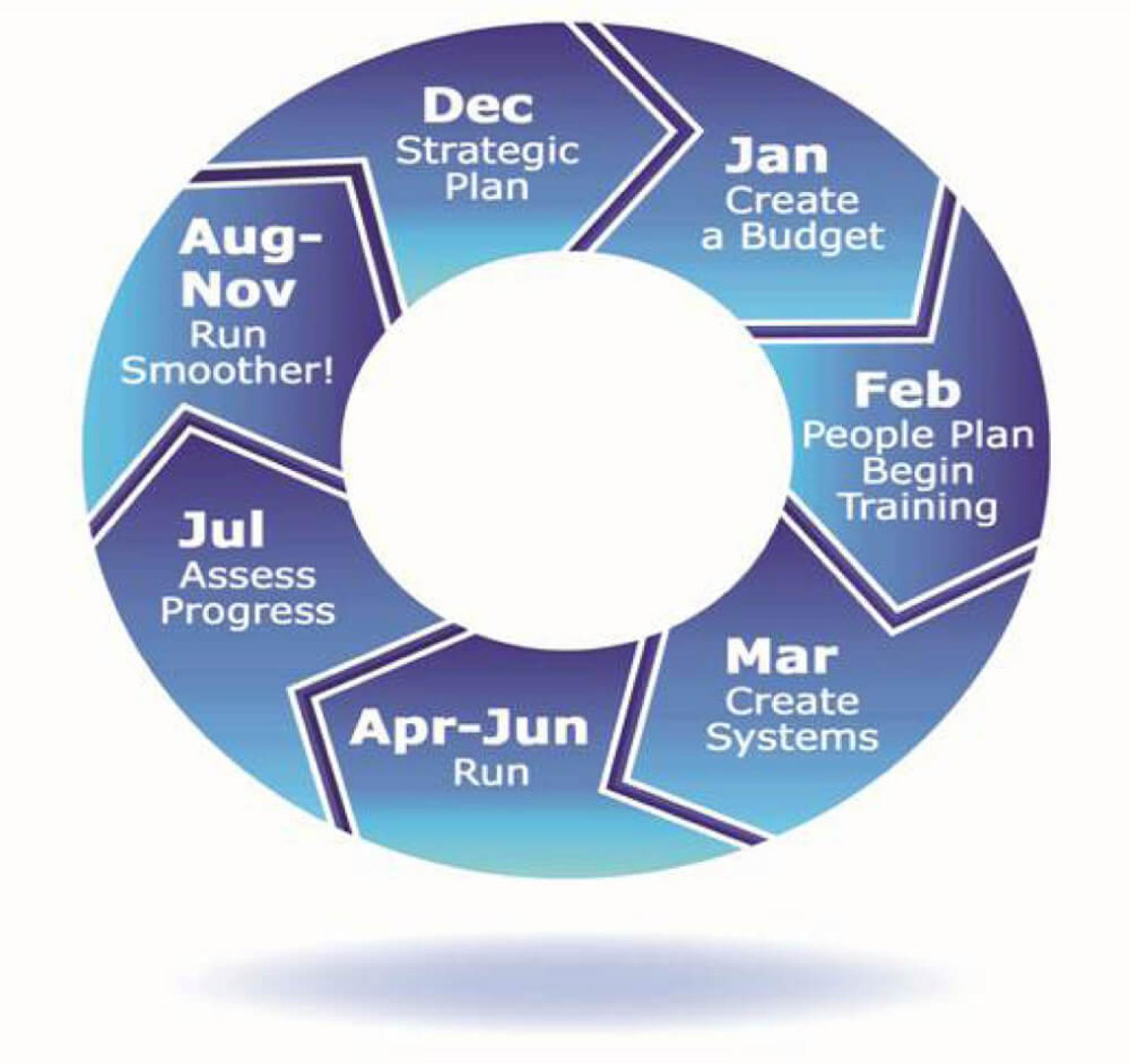March 15, 2011
A business model for growth and success

Above is a diagram of Bill’s business model. Note that each month contains a different initiative that, when followed year after year, helps keep Bill on track to accomplishing his business goals.
 With the first month of the year nearly over, and the busy work season fast approaching, Dan knew it was time to sit down for another informative chat with Bill. “Our meetings have changed the way I do business,” Dan said. “My only concern is moving forward. I want to make sure this year is the best year yet.”
With the first month of the year nearly over, and the busy work season fast approaching, Dan knew it was time to sit down for another informative chat with Bill. “Our meetings have changed the way I do business,” Dan said. “My only concern is moving forward. I want to make sure this year is the best year yet.”“I like to look at it this way: every year presents a new opportunity for growth and success,” Bill explained. “With the right people, planning, systems and processes in place, you’ve armed yourself with the necessary resources to see your business thrive.”
“You can have the best of intentions, but none of that is any good if you don’t know when and how to implement and develop your resources,” said Dan.
“I see,” says Bill, pausing to think of the best way to help his friend out. “What if I gave you a quick insider’s look at how I run my business, month by month, throughout the year? I’ll outline the steps involved in planning my business better and working smarter to ensure we’re on the path to profitability, then perhaps you can follow the same model for your own business.”
January: Create a budget
“January is the start of a new year, which means it’s time to set the wheels in motion for the coming year. Now is the time to sit down and create an operating budget,” Bill explains. “An operating budget will allow you to support your opinions with actual numbers and will insert an element of logic and thought into your business plans, which is absolutely necessary when trying to set accurate goals.”“So you should use your budget almost like a map? Guiding you throughout the year?” Dan asks.
“Yes, exactly, but keep in mind that your operating budget is not meant to predict the future. It’s to be used as a map. If you don’t know where you’re supposed to be going, how are you going to get there? When you use your budget as a planning and management tool rather than a forecast that hangs on a wall, you’ll actually drive your projections to become reality. Also, make sure your budget is profitable. If you want to earn a profit, you need to plan for profit,” explained Bill.
“What would you classify as a ‘healthy’ budget?” Dan asked.
“A 10 per cent net profit margin is a good benchmark. Depending on the year and the state of the economy, it may be lower or higher. Your budget tells you what you need to sell, the labour costs and overhead you can afford, and exactly how to price your work to make your plan become reality.”
Dan asked, “Once you have your budget in place, what’s next?”
“The right people,” said Bill.
February: People plan
“The right people?” Dan asked, confused. “But it’s only February, and we don’t usually start hiring until April, when we actually need the guys on the job.”“That’s a problem,” said Bill, “The last thing you should do is wait until you need people to start the hiring process.”
“But isn’t that common practice to equate springtime with hiring time?” Dan asked.
“It is common practice, but that doesn’t make it smart,” said Bill. “Think of it this way: when you hire new employees in April, you’re already busy. As a result, you end up pushing them out the door and into a truck on their first day. Not only is there no time to train new employees, there’s no time to align them with your company culture. And, in April, you’ve likely missed out on the best people, because they’ve already been scooped up by your competitors.
“Start planning, interviewing and training in February. That gives you plenty of time to follow the proper hiring process, which includes running new hires through a working interview and orientation to ensure they’re a good fit for the job and a good fit for your company. When you hire in February, you have the opportunity to find and hire the best people. They’re on probation. Put them to work organizing the shop and trucks before the season starts. Test them out before you need them. You may pay for a few more downtime hours, but the cost is minimal compared to working with untrained, unmotivated, unfit workers.”
“So I have my budget and team of trained employees, what’s the goal for March?” asked Dan.
March: Create systems
“March should be all about getting the right systems in place. Imagine your office, yard and shop looking and running like the Home Depot. Every department has a label. Every department has categories and every item in each department is labelled. There is a return section. This concept allows for customers and employees to always follow the same system to easily find what they are looking for. You can and should set up your business in the same way.“Take the time to get your paperwork processes in order, to create job binders for work already sold, or route binders for maintenance crews. Make sure everyone knows the answers to the critical components of your business: what needs to be done, who’s going to do it, and how it’s going to be done. By the end of March, you should be ready for the busy season ahead with your systems in place, explained Bill.”
April – June: Run
“This time of the year is busiest time for landscapers, so do as much work as you can in these months. You just spent the past few months getting the legwork in order. Put it to good use! Run according to the budget and systems you put in place in the beginning of the year,” said Bill.July: Assess progress
“As the heat sets in and momentum is established, take a step back from your busy schedule and analyze how your business is running. Look at your budget verses your actuals — this includes your sales, labour, expenses, sales to labour ratio, overhead spending and material spending. Look at these numbers and make sure you’re on track.”“What’s the best way to go about doing this?” asked Dan.
“A simple report that shows sales and the percentage of sales spent on labour, equipment, materials, subs, and overhead is all you really need to get started. Compare your actual to what you’ve budgeted. Drill into specific problems as they surface. Be sure look for ratios that are too high!” added Bill.
August - November: Run, but run smoother
“Your focus should be on fixing problems,” Bill said. “Thanks to the adjustments you made when you assessed your progress in July, your company should be running smoother. Fix problems as they happen, instead of finding out about them long after it’s too late.”December: Strategic planning
“As you approach the closing of this year, you should already have your mind set on the year to come,” said Bill. “Take time to reflect on your experiences this year, how can you take what you’ve learned and apply it to the next year? Start by looking at your company and determine what is good to keep in place and what needs to change. Ask yourself the following questions:- Who are your key people returning?
- Are you growing or holding steady?
- What’s the economic forecast for the coming year?
- Do you need to fill any key roles?
- Have you lost any key people?
- What equipment could make you more productive next year?
- What were your biggest bottlenecks, and what systems could help you work around them next year?
“And I guess just when it ends, it starts up again!” Dan says with a laugh.
Bill concluded his talk, “The only thing that stays the same is change. Get used to it. Every change is opportunity to be better, bigger, faster. You can seize every opportunity with good planning.”
Mark Bradley is the president of The Beach Gardener and the Landscape Management Network.